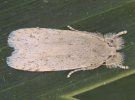Opisina arenosella Walker |
||||||||||||||||||||||||||||||||||||||||||||||
| Order: Lepidoptera Family: Oecophoridae | ||||||||||||||||||||||||||||||||||||||||||||||
| Common name : Black headed caterpillar | ||||||||||||||||||||||||||||||||||||||||||||||
The leaf-eating caterpillar Opisina arenosella is one of the major pests of coconut palm in India. The pest is serious in coastal tracts of the country particularly in Kerala and in interior parts of Karnataka, Tamil Nadu, Andhra Pradesh etc. It is also creating problems in Orissa, West Bengal, Bihar, Maharashtra and Gujarat. The caterpillars inhabit the lower surface of the leaflets in galleries made of silken threads reinforced with leaf scraps and excreta. They feed on the functional chlorophyll containing parenchymatous tissues of leaflets thereby reducing the photosynthetic efficiency and ultimately nut production. The pest also infests palmyrah, talipot, date (both wild and cultivated) and certain ornamental plants. |
||||||||||||||||||||||||||||||||||||||||||||||
The pest occurs throughout the year, but it is more serious in dry summer months particularly during February - March, if the rain is delayed high population can be expected in June. The female moth lays about 300 eggs. Egg, caterpillar, pupal and whole life cycle is completed in 3 to 7, 35-56, 9-14 and 60 days respectively. |
||||||||||||||||||||||||||||||||||||||||||||||
Chemical control measures suggested (whether spraying or stem injection or root feeding) are not always feasible, but it has been found that inundative releases of mass bred indigenous parasitoids give considerable relief. |
||||||||||||||||||||||||||||||||||||||||||||||
| Production procedure | ||||||||||||||||||||||||||||||||||||||||||||||
For rearing the host specific parasitoids the availability of right stage of the host has to be ensured. Earlier it has been accomplished by either collecting the Opisina arenosella larvae from the field and segregating them in different stages to utilize the right stage, or the host multiplied on coconut leaves in plastic containers. The leaf is changed and larvae transferred to fresh leaf every alternate day. Both these methods have uncertainities in mass production programmes. Now the insect is multiplied on the semisynthetic diet, the composi- tion of which is furnished in the following table. |
||||||||||||||||||||||||||||||||||||||||||||||
| Ingredients of the artificial diet for rearing Opisina arenosella | ||||||||||||||||||||||||||||||||||||||||||||||
|
||||||||||||||||||||||||||||||||||||||||||||||
Ingredients of fraction A are placed in blender bowl. Fraction B i.e., the coconut leaf powder is added to 50 ml of distilled water heated to 60-70oC and stirred well. This fraction B is added after 10 minutes to fraction A in the blender bowl and mixed thoroughly. Water in fraction C is heated and after adding agar allowed to boil and then poured into the bowl and blended. The mixture is poured into sterilized plastic jars (12 x 10 cm) to depth of about 2.5 cm and allowed to cool. |
||||||||||||||||||||||||||||||||||||||||||||||
Moths of O. arenosella are released in sterilized plastic jars (12 x 10 cm with wire gauge windows for aeration) in which a piece of coconut leaf washed thoroughly in water and wiped dry is placed. A thin layer of cotton lint is provided on a piece of paper which acts as oviposition site. At the black-head stage, the cotton lint to which the eggs adhere is spread on the surface of the diet in the jar. By adopting this method, handling is minimised. After feeding on the surface of the diet for about two weeks, the larvae move on to the space between the jar and diet at the sides and start feeding on the diet forming galleries. The female developed on this diet lays about 60 eggs. The larval stage, pupal stage and the entire life cycle are completed in about 32, 9 and 42-48 days, respectively. |
||||||||||||||||||||||||||||||||||||||||||||||
|

